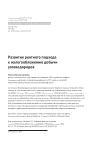Investigation of consumer actions in the context of the need for import substitution in the Russian oil and gas industry
DOI: 10.33917/mic-1.120.2025.74-81
In the context of modern sanctions against Russia and the high demand of various types of oil and gas business for material and technical resources, equipment, and technologies, it is necessary to consider various scenarios for the development of the situation. At the same time, for making managerial decisions, including in the field of resource procurement, it is possible to compare the postulates of microeconomics on consumer behavior with the situation in the field of purchasing necessary equipment, spare parts, basic and auxiliary materials for the needs of oil and gas production. The results of the work provide opportunities for systematization of factors influencing decision-making in the search for import-substituting technological equipment for oil and gas production or the purchase of affordable fixed and working capital of foreign or domestic production.
References:
1. Makhovikova G.A. Microeconomics. Advanced course: textbook and practice for universities / G. A. Makhovikova, S. V. Pereverzeva. Moscow: Yurait Publishing House, 2025. 313 с.
2. Federal Law of 05.04.2013 № 44-FZ «On the contractual system in the sphere of procurement of goods, works, services to ensure state and municipal needs». URL: https://www.consultant.ru/document/cons_doc_LAW_144624/
3. Pelmeneva A.A. Assessment of the oil and gas equipment quality influence on the economic efficiency of the company activity. Management of quality in oil and gas complex (UKANG). 2013;3:23-26.
4. Pelmeneva A.A. Formation of innovative mechanisms of economic development of Russia. Microeconomics. 2023;5:5-15.
5. Federal Law of 18.07.2011 No. 223-FZ (ed. 08.08.2024) «On Procurement of Goods, Works, Services by Certain Types of Legal Entities» (with amendments and additions, effective from 01.01.2025). URL: https://www.consultant.ru/document/cons_doc_LAW_116964/
6. Federal Law of 31.12.2014 № 488-FZ (ed. of 30.11.2024) «On Industrial Policy in the Russian Federation» (with amendments and additions, effective from 20.12.2024). URL: https://www.consultant.ru/document/cons_doc_LAW_173119/
7. List of goods (including those supplied in the course of performance of purchased works, provision of purchased services) originating from foreign states, works, services, respectively performed, rendered by foreign citizens, foreign legal entities, in respect of which the prohibition of purchases for state and municipal needs, purchases by certain types of legal entities is established. URL: https://www.consultant.ru/document/cons_doc_LAW_494318/dc1993c2b5c2478f2ab15f73dba12882e6b458c8/











